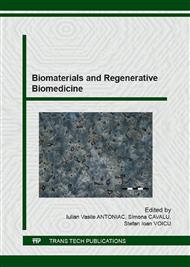[1]
M.E. Adams, M.H. Atkinson, A.J. Lussier, J.I. Schulz, K.A. Siminovitch, J.P. Wade, et al, The role of viscosupplementation with hylan G-F 20 (Synvisc) in the treatment of osteoarthritis of the knee: A Canadian multicenter trial comparing hylan G-F 20 alone, hylan G-F 20 with non-steroidal anti-inflammatory drugs (NSAIDs) and NSAIDs alone, Osteoarthritis Cartilage 3(1995).
DOI: 10.1016/s1063-4584(05)80013-5
Google Scholar
[2]
T. Neumayer, A. Prinz, O. Findl, Effect of a new cohesive ophthalmic viscosurgical device on corneal protection and intraocular pressure in small-incision cataract surgery, J Cataract Refract Surg, 34(2008) 1362-6.
DOI: 10.1016/j.jcrs.2008.04.018
Google Scholar
[3]
F.S. Brandt, A. Cazzaniga, Hyaluronic acid gel fillers in the management of facial aging, Clin Interv Aging, 3(2008) 153-159.
DOI: 10.2147/cia.s2135
Google Scholar
[4]
I.C. Stirbu, A.C. Fasui, S.M. Popescu, D. Iorgulescu, V. Mercut, Hyaluronic acid – innovative therapeutic method for gingival interdental papilla reconstruction, Current Health Sciences Journal, suppl 10 (2014) 56-59.
Google Scholar
[5]
A. Pagnacco, R. Vangelisti, C. Erra, A. Poma, Double-blind clinical trial versus placebo of a new sodium-hyaluronate- based gingival gel, Attualita Terapeutica Internazionale, 15(1997) 1-7.
Google Scholar
[6]
D. Scharnweber, L. Hübner, S. Rother, U. Hempel, U. Anderegg, S.A. Samsonov, M.T. Pisabarro, L. Hofbauer, M. Schnabelrauch, S. Franz, J. Simon, V. Hintze. Glycosaminoglycan derivatives: promising candidates for the design of functional biomaterials. J Mater Sci Mater Med. 2015 Sep; 26(9): 232.
DOI: 10.1007/s10856-015-5563-7
Google Scholar
[7]
U. Hempel, C. Preissler, S. Vogel, S. Moller, V. Hintze, J. Becher, et al, Artificial extracellular matrices with oversulfated glycosaminoglycan derivatives promote the differentiation of osteoblast-precursor cells and premature osteoblasts, Biomed Res Int, Article ID 938368 (2014).
DOI: 10.1155/2014/938368
Google Scholar
[8]
U. Hempel, V. Hintze, S. Moller, M. Schnabelrauch, D. Scharnweber, P. Dieter, Artificial extracellular matrices composed of collagen I and sulfated hyaluronan with adsorbed transforming growth factor beta 1 promote collagen synthesis of human mesenchymal stromal cells, Acta Biomater, 8(2012).
DOI: 10.1016/j.actbio.2011.10.026
Google Scholar
[9]
U. Hempel, S. Moller, C. Noack, V. Hintze, D. Scharnweber, M. Schnabelrauch, et al, Sulfated hyaluronan/collagen I matrices enhance the osteogenic differentiation of human mesenchymal stromal cells in vitro even in the absence of dexamethasone, Acta Biomater, 8(2012).
DOI: 10.1016/j.actbio.2012.06.039
Google Scholar
[10]
J. Salbach, S. Kliemt, M. Rauner, T.D. Rachner, C. Goettsch, S. Kalkhof, et al, The effect of the degree of sulfation of glycosaminoglycans on osteoclast function and signaling pathways, Biomaterials, 33(2012) 8418–29.
DOI: 10.1016/j.biomaterials.2012.08.028
Google Scholar
[11]
M. Schulz, P. Korn, B. Stadlinger, U. Range, S. Moller, J. Becher, et al, Coating with artificial matrices from collagen and sulfated hyaluronan influences the osseointegration of dental implants, J Mater Sci Mater Med, 25(2014) 247–58.
DOI: 10.1007/s10856-013-5066-3
Google Scholar
[12]
P. Korn, M. Schulz, V. Hintze, U. Range, R. Mai, U. Eckelt, et al, Chondroitin sulfate and sulfated hyaluronan-containing collagen coatings of titanium implants influence peri-implant bone formation in a minipig model, J Biomed Mater Res A, 102(2014).
DOI: 10.1002/jbm.a.34913
Google Scholar
[13]
D. Campoccia, P. Doherty, M. Radice, P. Brun, G. Abatangelo, D.F. Williams, Semisynthetic resorbable materials from hyaluronan esterification, Biomaterials, 19 (1998) 2101-2127.
DOI: 10.1016/s0142-9612(98)00042-8
Google Scholar
[14]
T. Sasaki, C. Watanabe, Stimulation of osteoinduction in bone wound healing by High-molecular hyaluronic acid, Bone, 16(1995) 9-15.
DOI: 10.1016/8756-3282(95)80005-b
Google Scholar
[15]
P.H. Weigel, G.M. Fuller, R.D. LeBoeuf, A model for the role of hyaluronic acid and fibrin in the early events during the inflammatory response and wound healing, J Theor Biol, 119 (1986) 219-234.
DOI: 10.1016/s0022-5193(86)80076-5
Google Scholar


